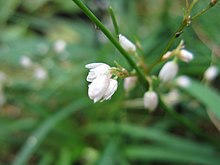프루누스 만수리카
Prunus mandshurica| 프루누스 만수리카 | |
|---|---|
 | |
| 벌과 함께 만주의 살구꽃 | |
| 과학적 분류 | |
| 킹덤: | 플랜태 |
| 클래드: | 기관지동물 |
| 클래드: | 안기오스페름스 |
| 클래드: | 에우디코츠 |
| 클래드: | 로시즈 |
| 순서: | 로잘레스 |
| 패밀리: | 로사과 |
| 속: | 프루누스 |
| 하위 게놈: | 프루너스 서브그.프루누스 |
| 섹션: | 프루누스 종파.아르메니아카 |
| 종: | P. 맨슈리카 |
| 이항식 이름 | |
| 프루누스 만수리카 | |
| 동의어[1] | |
| |
프루누스 만수무리차(Prunus mandshurica)는 만주 살구, 스카우트 살구라고도 불리며,[citation needed] 프루누스속(Prunus속)에 속하는 나무다.
1883년 카를 막시모비치에 의해 시베리안 살구(티베탄 살구) 프루누스 아르메니아아의 다양한 모습으로 처음 묘사되었다.[2]추위에 견디며 중국 동북부, 한국, 만주 등이 원산지다.매실포크스포티바이러스에 매우 취약하다.[3]
설명
프루누스 만수르리카는 낙엽이 많고 잎이 넓은 나무로 높이 약 10m(33ft)까지 자란다.속껍질은 빨갛고 겉껍질은 검다.잎은 타원형이며 끝이 길쭉하고(아큐메이트 또는 가미레이트), 일부 털, 톱니 모양의 가장자리가 있다.그 나무는 암토에서 가장 잘 자란다.그것의 꽃잎은 3cm(1.2인치)이다.세팔과 꽃잎은 타원형인 반면, 수술의 길이는 컵 모양의 오명과 비슷하다.꽃은 봄에 나타나며 흰색 또는 연분홍색이다.[4]과일은 늦여름에 나타나며 노란색과 약간의 붉은색을 띤다.가을에는 나뭇잎이 황금빛 주황색으로 변한다.[5][6][7][8]
사용하다
P. mandshurica에서 추출한 씨앗 기름은 바이오디젤의 원천으로 연구되어 왔다.프루누스 시비리카 씨앗의 오일 함량은 현저히 낮지만 바이오디젤의 원천으로서도 잠재력이 있다.화장품, 비누, 콜드크림 등에 사용되어 왔으며 항균성 프롤레틴의 원료이기도 하다.한의학 개업자들은 말린 알맹이가 천식과 변비 치료에 유용하다고 믿는다.[6][9][10][11][12][13]
컬티바스
경운기로는 '만단', 하이브리드 '몽골드', '선골드',[6] var. glabra 등이 있다.[2]
명명법
중국에서는 북동쪽 살구(중국어: 北北杏) 또는 랴오닝 살구(중국어: 辽杏)–로 알려져 있는데, 두 이름 모두 만주의 지리적 위치를 묘사하고 있다.우리말로는 개살구나무(개al나na무)로 알려져 있다.
참조
- ^ "Prunus mandshurica". Germplasm Resources Information Network (GRIN). Agricultural Research Service (ARS), United States Department of Agriculture (USDA). Retrieved February 3, 2014.
- ^ a b "Prunus armeniaca var. mandshurica". Germplasm Resources Information Network (GRIN). Agricultural Research Service (ARS), United States Department of Agriculture (USDA). Retrieved January 30, 2014.
- ^ Dicenta, F.; Rubio, M.; Martinez-Gomez, P. (2006). "Susceptibility to Sharka (Plum Pox Potyvirus) in Prunus mandshurica x Prunus armeniaca Seedlings". Acta Horticulturae. 701: 223–226. doi:10.17660/ActaHortic.2006.701.33.
- ^ "Prunus mandshurica - Plant Finder".
- ^ Cuizhi Gu; Chaoluan Li; Lingdi Lu; Shunyuan Jiang; Crinan Alexander; Bruce Bartholomew; Anthony R. Brach; David E. Boufford; Hiroshi Ikeda; Hideaki Ohba; Kenneth R. Robertson & Steven A. Spongberg (2003). "Armeniaca mandshurica". Flora of China online. eFlora.
- ^ a b c "Manchurian Apricot (Prunus armeniaca var. mandshurica)" (PDF). North Dakota State University. Retrieved January 30, 2014.
- ^ Wilson, Ernest Henry (1920). The Romance of our Trees. Garden City, NY: Doubleday, Page, and Co. p. 214.
- ^ "Prunus mandshurica" (PDF). Arnoldia. Arnold Arboretum, Harvard University. 3 (2). 1917.
- ^ Acton, Ashton (2013). Issues in Fossil Fuel Energy Technologies. Atlanta: Scholarly Editions. p. 424. ISBN 978-1-4901-0684-7.
- ^ Wang, Libing; Yu, H. (2012). "Biodiesel from Siberian Apricot (Prunus sibirica L.) Seed Kernel Oil". Bioresource Technology. 112: 355–358. doi:10.1016/j.biortech.2012.02.120. PMID 22440572.
- ^ Wang, Libing (2013). "Properties of Manchurian apricot (Prunus mandshurica Skv.) and Siberian apricot (Prunus sibirica L.) Seed Kernel Oils and Evaluation as Biodiesel Feedstocks". Industrial Crops and Products. 50: 838–843. doi:10.1016/j.indcrop.2013.08.072.
- ^ Xinrong, Yang (2003). Encyclopedic Reference of Traditional Chinese Medicine. Berlin: Springer-Verlag. p. 26. ISBN 3-540-42846-1.
- ^ Russo, Ethan B.; Hou, Joseph (2005). The Healing Power of Chinese Herbs and Medicinal Recipes. Binghamton, NY: Haworth Press. pp. 364–365. ISBN 0-7890-2202-8.
외부 링크
| 위키미디어 커먼즈에는 프루누스_만드슈리카와 관련된 미디어가 있다. |


